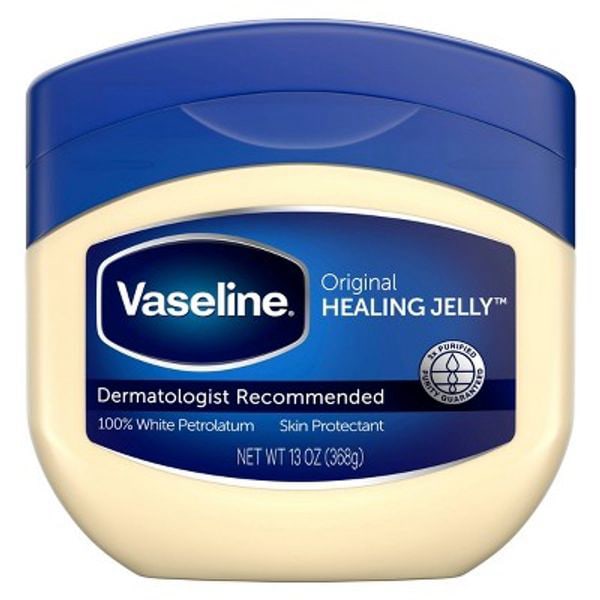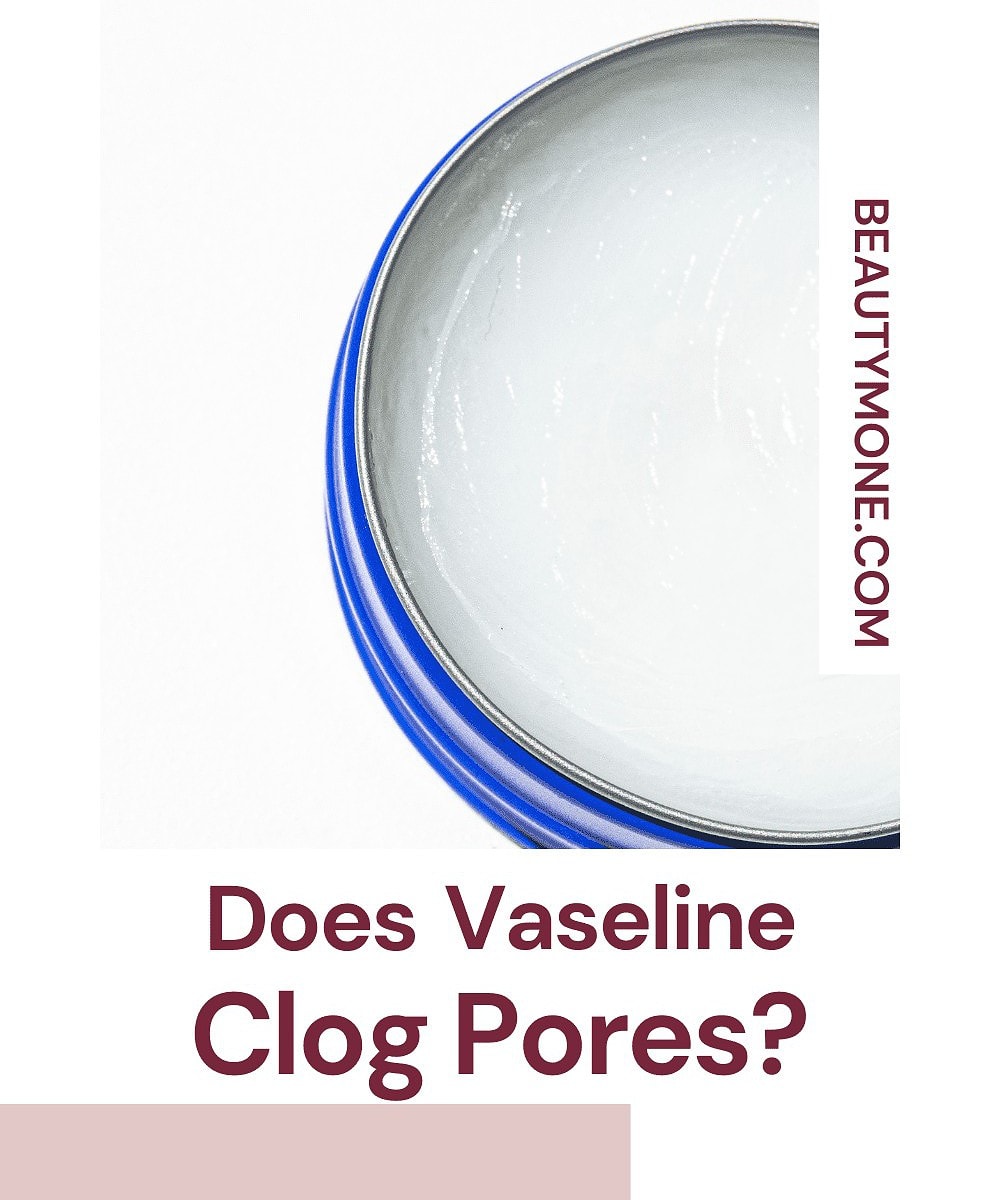
When you’re dealing with skin issues, it’s essential to find skincare products that do more good than harm. One age-old product battles everything from dry lips to minor skin abrasions: Vaseline. But, you might wonder if this catch-all solution is entirely safe for your skin.
A common concern when using Vaseline is its potential to clog pores. So, does Vaseline clog pores? The short answer is: not really. Vaseline is made of petroleum jelly, meaning it’s non-comedogenic.
That’s right; it won’t clog your pores and, in fact, can help lock in moisture, keeping your skin soft and supple. However, don’t just start slathering Vaseline on your face without a second thought!
It’s crucial to consider your skin type, existing skin issues, and other factors before relying on Vaseline as your go-to skincare fix. Each individual’s skin is different – and what works for one person may not be the best solution for you.
Understanding Pore Clogging
To fully grasp the concept of pore-clogging, it’s important to first understand what pores are and how they function.
Pores are tiny openings on the surface of your skin that serve as channels for sweat, natural oils, and hair to pass through. They’re crucial for maintaining healthy skin, as they help regulate temperature, moisturize, and protect it from external elements.
In certain circumstances, pores can become clogged. When this happens, it can lead to various skin problems, such as acne, blackheads, and enlarged pores. Clogged pores are mainly caused by the following:
- Excessive secretion of sebum (oil produced by sebaceous glands)
- A build-up of dead skin cells
- Bacteria and dirt accumulation
Nowadays, the question arises: does Vaseline clog pores? To answer this, it’s essential to look at Vaseline’s primary ingredient: petroleum jelly. It’s a semi-solid mixture derived from petroleum, and it’s commonly used in skincare products due to its moisturizing properties.
There’s a misconception that Vaseline, and by extension, petroleum jelly, has a pore-clogging effect. In reality, Vaseline is non-comedogenic, meaning it doesn’t clog pores or cause acne. Vaseline’s molecular size is too large to penetrate the pore, meaning it won’t get trapped and cause clogging.
However, that doesn’t mean Vaseline is suitable for all skin types. The use of Vaseline can create a physical barrier on the skin’s surface, trapping moisture, bacteria, and sweat, which may contribute to the development of acne for some individuals, especially those with oily or acne-prone skin.
For this reason, it’s essential to keep the following factors in mind:
- Skin Type: Know your skin type and choose your skincare products accordingly. Vaseline may work well for dry skin but could be problematic for those with oily or acne-prone skin.
- Application Method: Apply Vaseline in a thin layer. Too much can make it harder for the skin to breathe and exacerbate oiliness.
- Cleanliness: Ensure your skin is clean before applying Vaseline, as it forms a barrier that can trap dirt and bacteria on the skin’s surface.
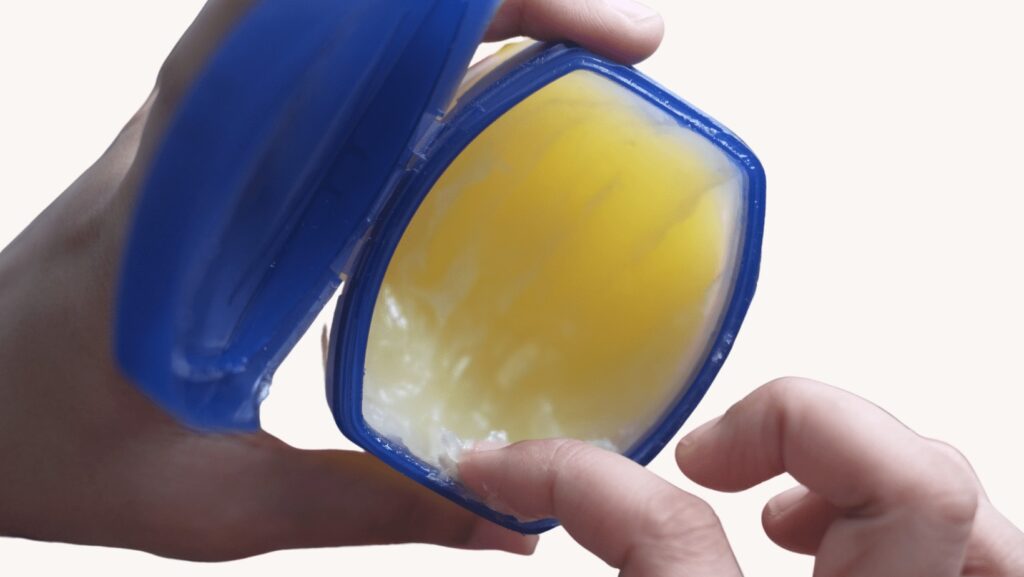
Vaseline’s Ingredients And Your Skin
Vaseline, also known as petroleum jelly, contains only one major ingredient: petrolatum. Petrolatum is a semi-solid mixture of hydrocarbons and is derived from petroleum.
Petroleum jelly, the primary component in Vaseline, comes from the refining process used to extract crude oil. It has been a popular skincare product for over a century, attributed to its multiple benefits. Among these benefits are:
- Moisturizing the skin
- Healing minor cuts and burns
- Protecting against windburn and chapped skin
One common concern about petroleum jelly is whether it causes acne by clogging pores. Here’s the important truth to know: Vaseline is non-comedogenic, which means it does not clog pores. Research done by the University of Pennsylvania School Of Medicine confirms this.
In fact, the American Academy of Dermatology (AAD) affirms that petroleum jelly can be beneficial for protecting and moisturizing acne-prone skin. While petrolatum can be beneficial for the skin, it’s important to consider other factors that make it effective:
- Purity: Vaseline’s petrolatum is highly refined, making it safe for use on the skin. It’s also non-comedogenic, which means it won’t clog pores or cause acne breakouts. The United States Pharmacopeia (USP) and European Pharmacopeia have set purity standards for petrolatum, ensuring your skin isn’t exposed to harmful impurities.
- Occlusive effect: Vaseline works as an occlusive agent, forming a barrier on the skin’s surface. This barrier can prevent water loss and keep skin hydrated, especially for dry or sensitive skin types. However, occlusive agents don’t add any nutrients or vitamins to the skin.
People with oily or acne-prone skin might want to use lighter moisturizers, as Vaseline’s heavy occlusive effect may not be compatible with their skin type. On the other hand, those with dry, sensitive, or eczema-prone skin may benefit from Vaseline’s hydration and protection.
Here’s a quick comparison chart to help you decide if Vaseline is right for your skin:
| Skin Type | Vaseline Suitability |
|---|---|
| Dry | Yes |
| Sensitive | Yes |
| Eczema-prone | Yes |
| Oily | Less suitable |
| Acne-prone | Less suitable |
Due to the occlusive effect, Vaseline can be a trigger for acne breakouts when you have oily or acne-prone skin. However, it doesn’t have to cause breakouts. Some people even say it helps with their acne.
Just know that you should be careful using Vaseline when you have oily or acne-prone skin, as several dermatologists still don’t recommend it for these skin types. Make sure to patch-test on a small part of your face or consult a dermatologist before using Vaseline over your face.
So, Does Vaseline Clog Pores?
We’ve said it already, but to clarify one more time, Vaseline is non-comedogenic, meaning it doesn’t clog pores or cause acne. Also, Vaseline confirms this on Vaseline’s company website.
It’s worth noting that although Vaseline is effective in retaining moisture in the skin, some professionals have raised concerns that it could also potentially trap oil and dirt.
As such, the American Academy of Dermatology (AAD) warns that people who are prone to acne may experience breakouts after applying Vaseline to the face.
Comedogenic Rating
Common ingredients in skincare products are rated on a scale of 0–5. The higher the number is, the higher the chances are that your pores may get clogged.
Generally, values of 2 and below are unlikely to cause clogged pores. So products containing ingredients with these scores are considered non-comedogenic.
The comedogenic scale ranges from 0-5 and looks like this:
- 0: Does not clog pores
- 1: Low chance of clogging pores
- 2: Moderately low chance of clogging pores
- 3: Moderate chance of clogging pores
- 4: Relatively high chance of clogging pores
- 5: High chance of clogging pores
Petrolatum, Vaseline’s main ingredient, is rated a 0. This means that it does not clog pores.
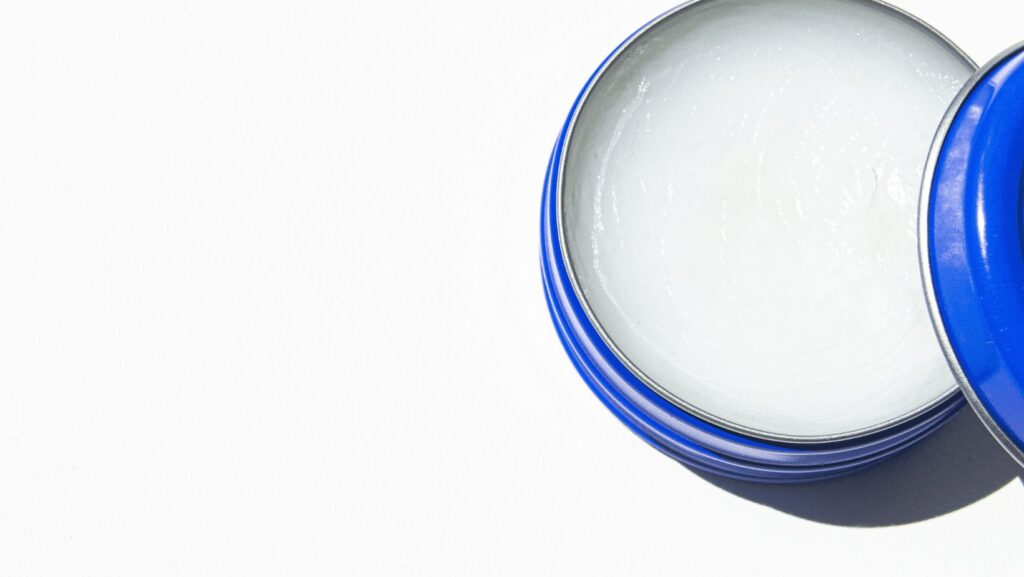
What Is Vaseline?
Vaseline is a brand of petroleum jelly-based products owned by Anglo, a Dutch company, Unilever. Petroleum jelly was discovered in 1859 by Robert Chesebrough, and he named it Vaseline after the German word for water (Wasser) and the Greek word for oil (elaion).
It was initially used as a topical ointment to treat cuts, burns, scrapes, and other skin irritations. Today, Vaseline has become a household name thanks to its versatile use in everything from moisturizing dry skin to helping heal wounds.
It’s made up of refined petrolatum that forms an oily barrier on the surface of your skin which helps retain moisture while preventing dirt and bacteria from entering pores. This also makes it useful for removing makeup or taming flyaways in hair.
Vaseline comes in several varieties, such as lotions, creams, and gels specially formulated with different ingredients like aloe vera extract or cocoa butter to provide extra benefits depending on what you need.
Even lip balms containing petroleum jelly and natural oils like coconut oil or shea butter are available. Hence, lips stay hydrated throughout the day without becoming too greasy or heavy.
The classic white Vaseline product can be found almost anywhere, including drug stores and supermarkets. Still, more specialized versions are sold at beauty supply stores if you’re looking for something even more luxurious.
Ultimately no matter what type you choose, one thing remains true: Vaseline is sure to be an essential part of any modern medicine cabinet with its countless uses!
What Are The Benefits Of Vaseline?
Vaseline is a product that has been used for generations, and with good reason! It’s versatile, affordable, and can help improve the look and feel of skin in many ways. There are numerous benefits to using Vaseline on your skin:
It helps protect it from environmental elements like sun exposure or cold weather; it locks in moisture, so your skin stays hydrated. Its thick consistency can create a barrier between you and irritants.
Applying a small amount around the lips during cold winter months protects them from becoming dry or chapped due to harsh winds.
Another great benefit of using Vaseline is moisturizing power. Its hydrating properties allow for long-lasting moisture and lock in moisture – perfect for those who suffer from eczema, psoriasis, or extremely dry skin conditions where other creams may not be enough.
And because its thick consistency creates an occlusive barrier between you and outside irritants (like fabric softener), it’s also great for those who have sensitive skin types.
Finally, countless other uses make Vaseline one of the most popular products on store shelves today – everything from removing makeup residue to keeping leather goods looking shiny and new – making it even more helpful than ever before!
So if you’re looking for an all-purpose solution for keeping your skin healthy this season – give Vaseline a try!
What Are The Side Effects Of Vaseline?
Using Vaseline is generally considered to be safe, but it’s important to understand the potential side effects associated with its use. Besides the benefits of adding Vaseline to your skincare routine, you may also want to consider some of the following side effects:
- The most common side effect of using Vaseline is that it can clog pores (even though it’s non-comedogenic) if applied liberally on facial skin and other areas with a high concentration of oil glands. This can lead to breakouts and irritation, so it’s important not to overdo your application in these areas.
- Another possible risk factor involves allergies or hypersensitivity reactions. Petroleum jelly is an occlusive agent that can prevent air from reaching sensitive skin cells.
It’s best not to apply too much at once; instead, start by using only a small amount until you get used to how much works well for you without causing further issues such as flaking or cracking – which could leave your skin vulnerable to infections like staphylococcus bacteria that thrive in moist environments!
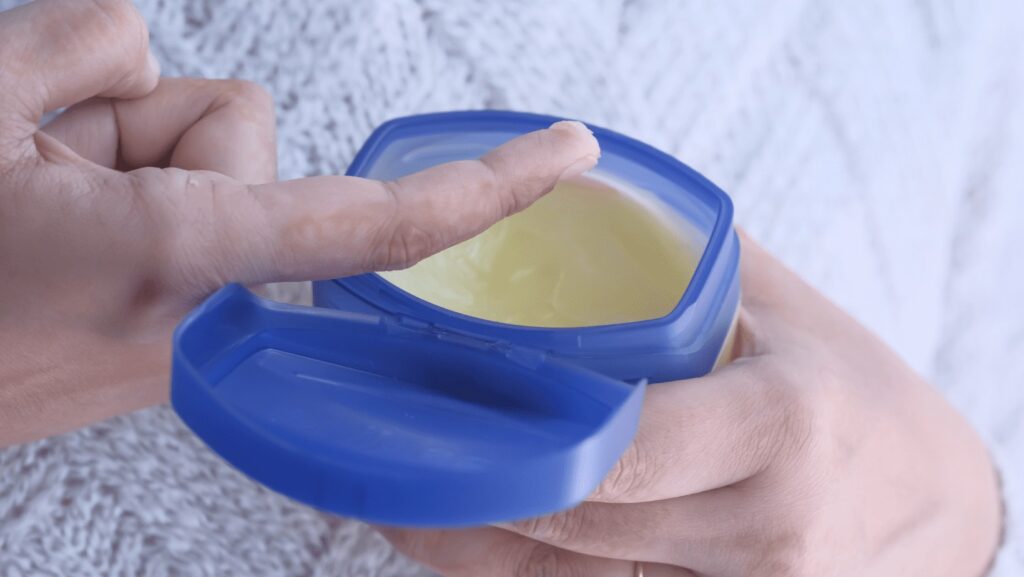
How To Apply Vaseline?
To use Vaseline safely and effectively, it’s important to know how to apply Vaseline correctly.
- Make sure you start by washing/cleansing before applying a thin layer of the product. This will help ensure that any dirt or bacteria on your skin won’t get trapped under the Vaseline when applying it. Also, avoid getting Vaseline in open wounds or near your eyes, as these areas are highly sensitive.
- Take some Vaseline onto two fingers – enough to cover the area where you want to apply it – make sure to apply a thin layer all over the face.
Pro tip: It’s best to use Vaseline at night – also called slugging – so it can lock in hydrating serums and/or moisturizers. Vaseline is basically just a layer that keeps the moisture locked into your skin, and you can wash it off in the morning.
It’s best not to rub too hard as this could irritate delicate skin; instead, try massaging lightly with gentle circular motions.
The Vaseline application process looks like this step-by-step:
- Wash the face with a gentle cleanser before applying Vaseline;
- Take enough Vaseline onto two fingers;
- Massage gently into the skin until absorbed;
- You can let it sit on for 10 minutes as a mask and wash it off or;
- Leave it on and sleep with it. Wash your face in the morning.
Conclusion On Does Vaseline Clog Pores?
In general, Vaseline doesn’t clog pores and is considered comedogenic. However, determining if Vaseline clogs your pores is not a simple yes or no answer. Your skin type, the way you apply it, and the frequency of usage play considerable roles in how Vaseline interacts with your pores.
For some people, Vaseline is a beneficial product, providing hydration and acting as an effective barrier for moisture retention. If you have dry or normal skin types, you may find it’s a helpful addition to your skincare routine.
On the flip side, if you have oily or acne-prone skin, using Vaseline could lead to potential problems. It’s worth considering the following factors:
- Vaseline is an occlusive agent: It forms an effective barrier on the skin, which can trap oils and bacteria, contributing to clogged pores in those with acne-prone skin.
- How much you apply matters: Applying a thick layer over acne-prone areas can result in congestion and exacerbate existing breakouts.
In conclusion, Vaseline is a versatile and widely-used skincare product. While it’s not a definitive pore-clogger, it may contribute to clogged pores for certain skin types, particularly oily and acne-prone ones.
When in doubt, consult a dermatologist and carefully observe your skin’s reaction to determine if Vaseline is a suitable product for you.
Frequently Asked Questions
shop the post

